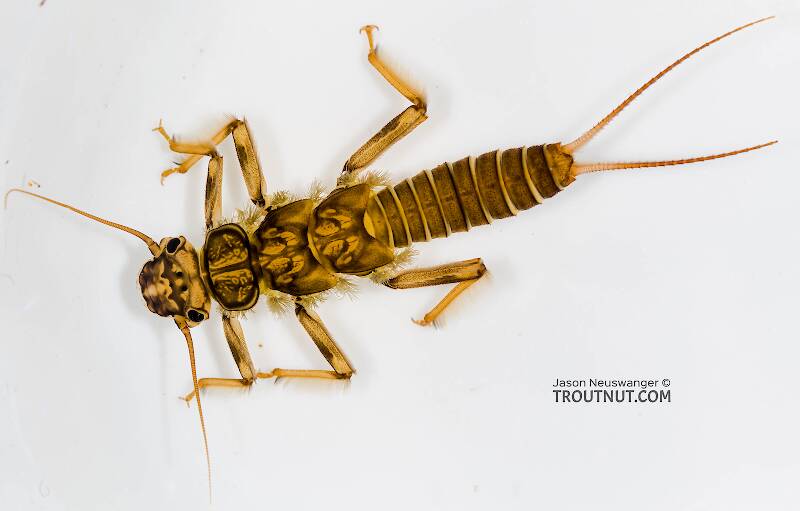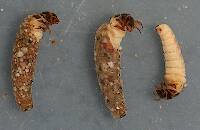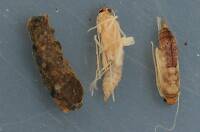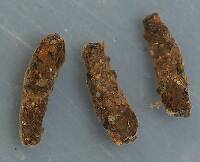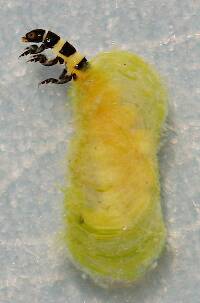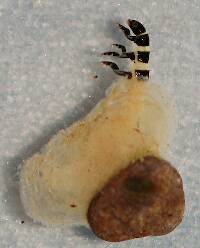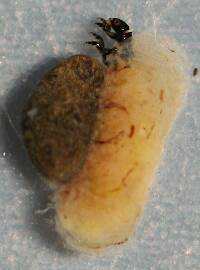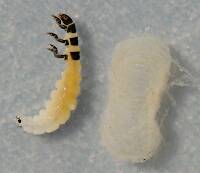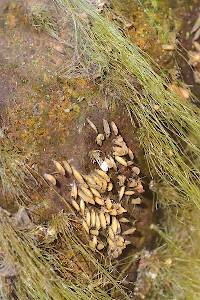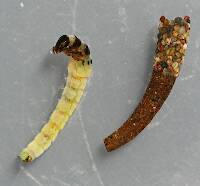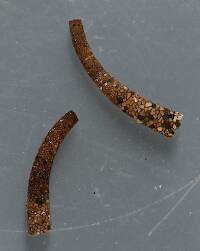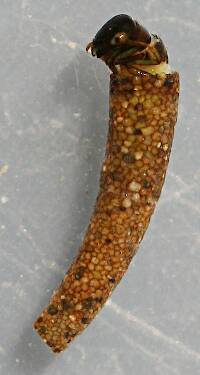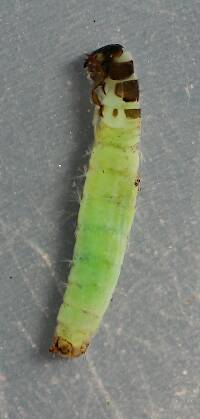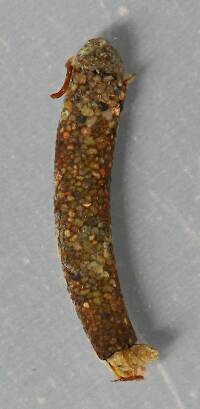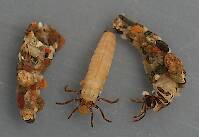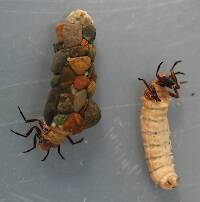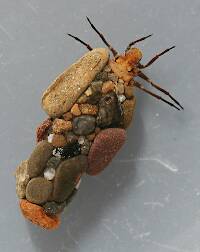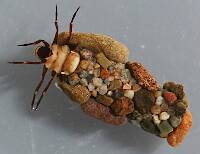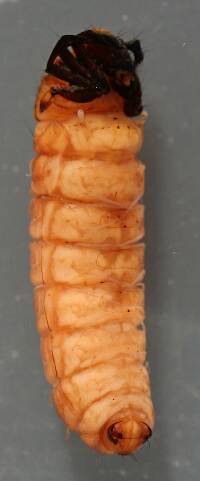
Hex Mayflies
Hexagenia limbata
The famous nocturnal Hex hatch of the Midwest (and a few other lucky locations) stirs to the surface mythically large brown trout that only touch streamers for the rest of the year.
Featured on the forum

Troutnut is a project started in 2003 by salmonid ecologist Jason "Troutnut" Neuswanger to help anglers and
fly tyers unabashedly embrace the entomological side of the sport. Learn more about Troutnut or
support the project for an enhanced experience here.
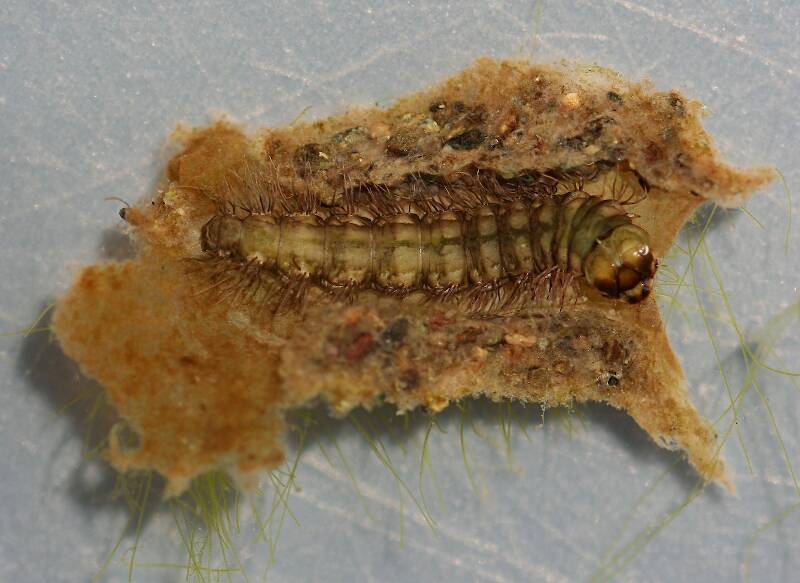
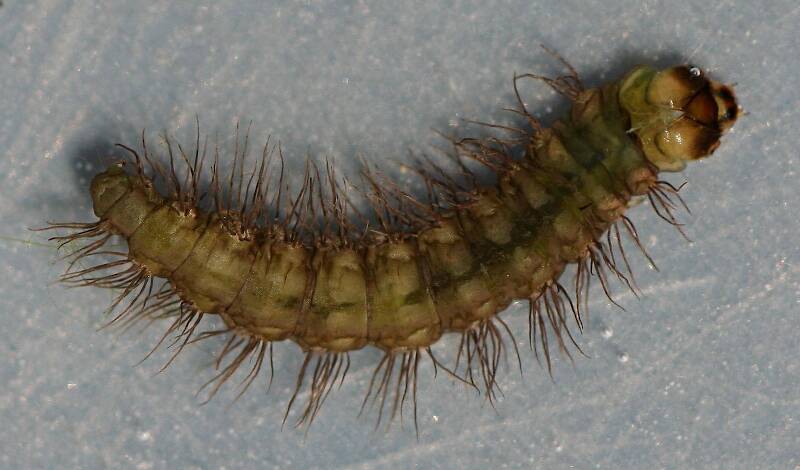
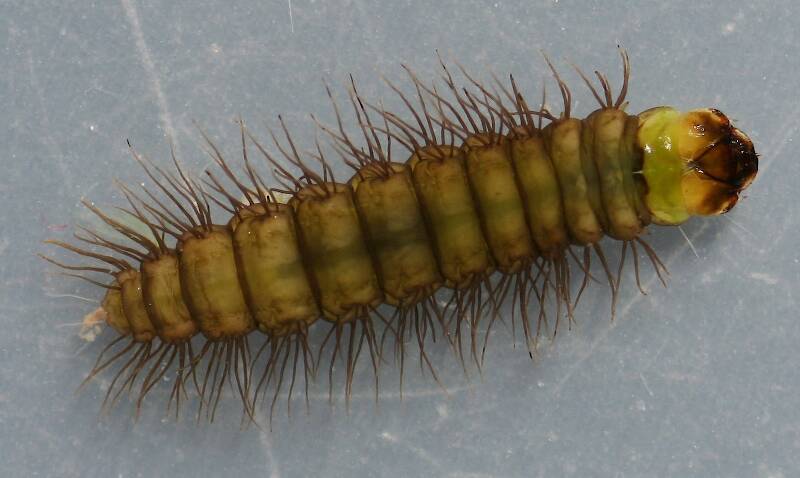

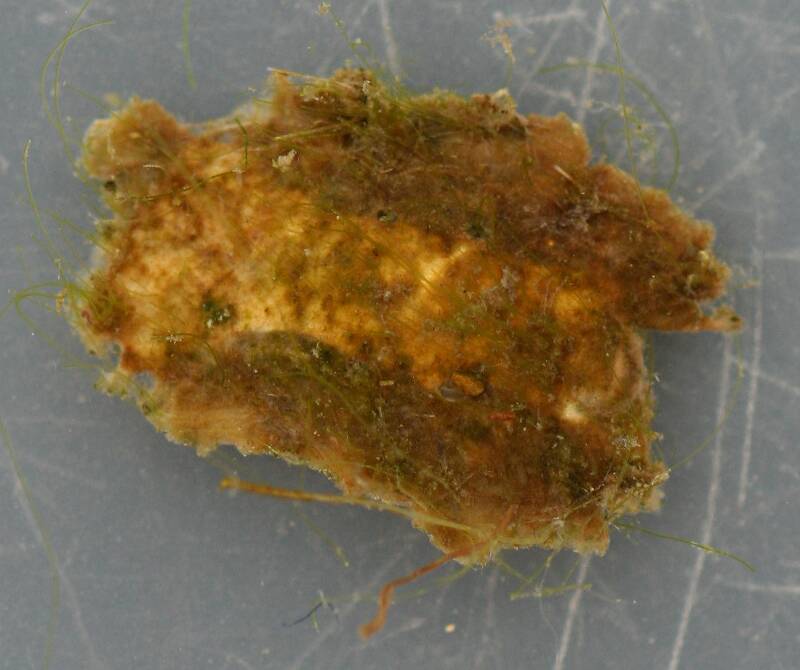
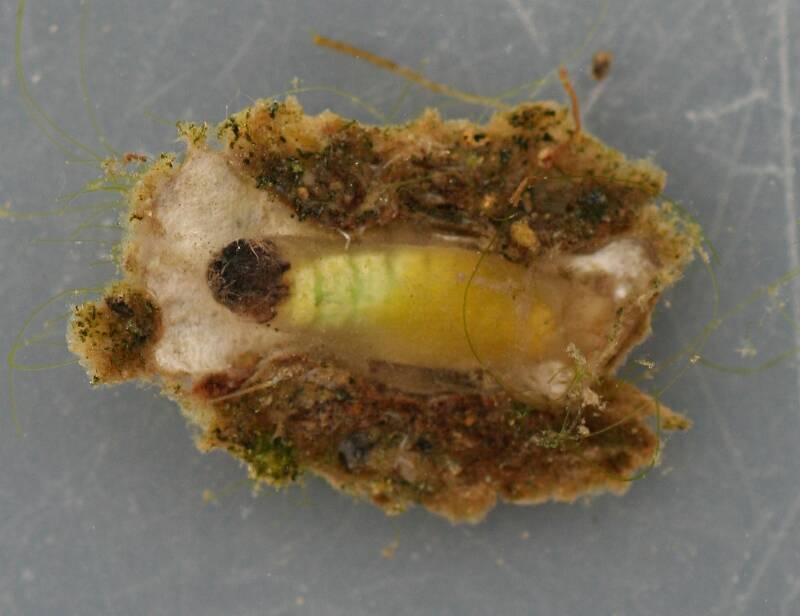
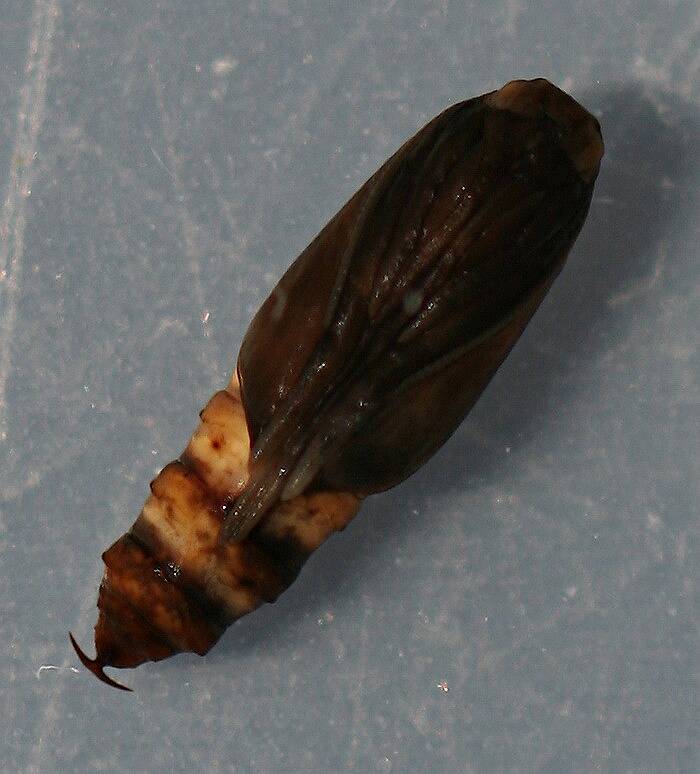
Millcreek on Aug 13, 2014August 13th, 2014, 9:17 am EDT
I've been finding these at the Russian River over the last few days. I was looking for caddisfly pupae and happened to notice mats of silk about the size of pennies or nickels on the top and sides of large pieces of cobble. Got curious and looked underneath a few and found these larvae and pupae which keyed out to Petrophila in Merritt, Cummins and Berg (2008). No idea what the species is. I haven't noticed any adults yet although some of the pupae look like they're about ready to emerge.
Found an interesting article on fishing the hatch in old issue of American Angler. It can be seen here http://cpw.state.co.us/Documents/LandWater/Riverwatch/EntomologyContents/AquaticMoths.pdf
Found an interesting article on fishing the hatch in old issue of American Angler. It can be seen here http://cpw.state.co.us/Documents/LandWater/Riverwatch/EntomologyContents/AquaticMoths.pdf
"If we knew what it was we were doing, it would not be called research, would it?"
-Albert Einstein
-Albert Einstein
Crepuscular on Aug 13, 2014August 13th, 2014, 9:59 am EDT
NICE! cool find. Aquatic lepidoptera seem to be few and far between here. Nice shot of the ventral aspect of the larva. Neat to be able to see the crochets.
Taxon on Aug 13, 2014August 13th, 2014, 10:34 am EDT
Very nice, Mark.
Millcreek on Aug 13, 2014August 13th, 2014, 10:38 am EDT
Eric - Yeah, I was real happy to find these, I'd never seen them before. Felt like a bit of a dumbass though since they're there in large numbers and I'd never noticed them before. All I can say in defense is that they're well camouflaged.
"If we knew what it was we were doing, it would not be called research, would it?"
-Albert Einstein
-Albert Einstein
Millcreek on Aug 13, 2014August 13th, 2014, 10:42 am EDT
Very nice, Mark.
Thanks, Roger. Any idea as to species?
"If we knew what it was we were doing, it would not be called research, would it?"
-Albert Einstein
-Albert Einstein
Taxon on Aug 13, 2014August 13th, 2014, 12:42 pm EDT
Hi Mark-
Although you will probably need to capture an adult in order to make a species level identification, Aquatic Insects Of California does has species level keys under the earlier genus name of Parargyractis.
Thanks, Roger. Any idea as to species?
Although you will probably need to capture an adult in order to make a species level identification, Aquatic Insects Of California does has species level keys under the earlier genus name of Parargyractis.
Millcreek on Aug 13, 2014August 13th, 2014, 1:47 pm EDT
Roger -
I've got a copy of that. Don't know why I didn't think of it. Looks like quite a bit of info on Petrophila under Parargyractis. Thanks.
Although you will probably need to capture an adult in order to make a species level identification, Aquatic Insects Of California does has species level keys under the earlier genus name of Parargyractis.
I've got a copy of that. Don't know why I didn't think of it. Looks like quite a bit of info on Petrophila under Parargyractis. Thanks.
"If we knew what it was we were doing, it would not be called research, would it?"
-Albert Einstein
-Albert Einstein
Lastchance on Aug 13, 2014August 13th, 2014, 1:54 pm EDT
Another sulfur.
PaulRoberts on Aug 13, 2014August 13th, 2014, 3:51 pm EDT
Amazing. Are those some type of gill filaments around spiracles?
Crepuscular on Aug 13, 2014August 13th, 2014, 4:45 pm EDT
Amazing. Are those some type of gill filaments around spiracles?
Paul, are you referring to the elongated structures on the sides of the larva or the crochets on the prolegs in the photo of the ventral side?
Millcreek on Aug 13, 2014August 13th, 2014, 5:02 pm EDT
Paul -
If you're asking about the filamentous structures on the lateral part of the larvae they're gills. Not sure about the larvae having spiracles, if they are present it's difficult to see them. The pupae have very noticeable spiracles, unfortunately they're easiest to see on the side and the only photo I posted shows a ventral view. If you're asking about the structures on the ventral area of the larva those are prolegs with the "claws" arranged around an oval area.
If you're asking about the filamentous structures on the lateral part of the larvae they're gills. Not sure about the larvae having spiracles, if they are present it's difficult to see them. The pupae have very noticeable spiracles, unfortunately they're easiest to see on the side and the only photo I posted shows a ventral view. If you're asking about the structures on the ventral area of the larva those are prolegs with the "claws" arranged around an oval area.
"If we knew what it was we were doing, it would not be called research, would it?"
-Albert Einstein
-Albert Einstein
PaulRoberts on Aug 13, 2014August 13th, 2014, 9:19 pm EDT
I was meaning the lateral filaments. They are arranged along the body in similar places as spiracules. Just curious as to whether they are associated with spiracules, or anatomically unique. Are hellgrammite gills the same anatomically? Don't go out of your way to answer (I can do that) -just curious.
Millcreek on Aug 14, 2014August 14th, 2014, 6:49 am EDT
I was reading up on these larvae last night and the lateral filaments are indeed gills associated with spiracles. I went back to the microscope and there are spiracles located in between the gills although they are difficult to see on the larvae.
In the taxonomic literature on Petrophila larvae the arrangement of the filamentous gills around the spiracles is used as a diagnostic feature.
I don't know if hellgrammite gills are similar but I'd be interested to hear what you find out.
In the taxonomic literature on Petrophila larvae the arrangement of the filamentous gills around the spiracles is used as a diagnostic feature.
I don't know if hellgrammite gills are similar but I'd be interested to hear what you find out.
"If we knew what it was we were doing, it would not be called research, would it?"
-Albert Einstein
-Albert Einstein
PaulRoberts on Aug 17, 2014August 17th, 2014, 4:43 pm EDT
Found this on Corydalus:
http://entnemdept.ufl.edu/creatures/misc/eastern_dobsonfly.htm
"Abdominal segments 1 through 8 have lateral tactile filaments which function to protect them from each other and from other small predators (Neunzig and Baker 1991), and segments 1 through 7 each has a pair of ventro-lateral tufts of tracheal gills that absorb dissolved oxygen (Barclay et al. 2005, Hoover et al. 1988). In addition to the tracheal gills, larvae also have spiracles allowing them to breathe both in and out of water. There are two prolegs at the tip of the abdomen -- each with a dorsal filament and a pair of terminal hooks to help the larvae anchor themselves to the substrate. The mandibles are powerful and heavily sclerotized."
http://entnemdept.ufl.edu/creatures/misc/eastern_dobsonfly.htm
"Abdominal segments 1 through 8 have lateral tactile filaments which function to protect them from each other and from other small predators (Neunzig and Baker 1991), and segments 1 through 7 each has a pair of ventro-lateral tufts of tracheal gills that absorb dissolved oxygen (Barclay et al. 2005, Hoover et al. 1988). In addition to the tracheal gills, larvae also have spiracles allowing them to breathe both in and out of water. There are two prolegs at the tip of the abdomen -- each with a dorsal filament and a pair of terminal hooks to help the larvae anchor themselves to the substrate. The mandibles are powerful and heavily sclerotized."
Millcreek on Aug 18, 2014August 18th, 2014, 6:14 am EDT
Paul - Thanks for the info. Looks like the filaments serve different purposes.
"If we knew what it was we were doing, it would not be called research, would it?"
-Albert Einstein
-Albert Einstein
Millcreek on Aug 24, 2014August 24th, 2014, 8:55 am EDT
Probably of no interest except for the bug geeks on the site but apparently if you find Petrophila larvae you have a chance of finding an aquatic Hymenoptera parasite as well. Paper on it is here http://biostor.org/cache/pdf/05/10/a7/0510a77977bda72401f5a277cf4fa2ac.pdf.
"If we knew what it was we were doing, it would not be called research, would it?"
-Albert Einstein
-Albert Einstein
Crepuscular on Aug 24, 2014August 24th, 2014, 6:55 pm EDT
Probably of no interest except for the bug geeks on the site but apparently if you find Petrophila larvae you have a chance of finding an aquatic Hymenoptera parasite as well. Paper on it is here http://biostor.org/cache/pdf/05/10/a7/0510a77977bda72401f5a277cf4fa2ac.pdf.
Nice. Vince R. Is right, you never hear about aquatic icneumonids or any aquatic Hymenoptera. Ok, now go find us a parasitized one! ;)
Millcreek on Aug 25, 2014August 25th, 2014, 5:52 am EDT
Ok, now go find us a parasitized one! ;)
Believe me, I've been looking. No luck so far, which I guess is good news for the Petrophila pupae.
If you're interested here's a link to some photos I took of some Ecdyonurus criddlei nymphs parasitized by a Symbiocladius (Diptera) species. http://bugguide.net/node/view/877481.
"If we knew what it was we were doing, it would not be called research, would it?"
-Albert Einstein
-Albert Einstein
Oldredbarn on Aug 27, 2014August 27th, 2014, 2:10 pm EDT
Nice. Vince R. Is right, you never hear about aquatic icneumonids or any aquatic Hymenoptera. Ok, now go find us a parasitized one! ;)
You are going to have to get a life, bro! :)
Spence
"Even when my best efforts fail it's a satisfying challenge, and that, after all, is the essence of fly fishing." -Chauncy Lively
"Envy not the man who lives beside the river, but the man the river flows through." Joseph T Heywood
"Envy not the man who lives beside the river, but the man the river flows through." Joseph T Heywood
Quick Reply
Related Discussions
Topic
Replies
Last Reply
1
Sep 5, 2006
by Troutnut
by Troutnut
2
Feb 6, 2017
by Crepuscular
by Crepuscular
5
Dec 4, 2008
by Beardius
by Beardius
4
Oct 29, 2014
by Millcreek
by Millcreek
0
Mar 31, 2008
by Fish4va
by Fish4va


